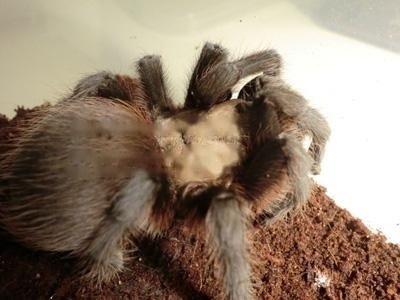
Texas Brown Tarantula
Adult body length is 13-14 cm, suitable temperature is 28-30 ℃, and suitable humidity is 65%. It is recommended to use moist peat, coconut brick and clay as the substrate. It tak
English name: Haplopelma Lividum
Character: Very vicious
Origin: Thailand
Lifetime: 20-25 years
Metallic BlueSpider (Latin name: Haplopelma lividum), also known as Thai cobalt blue bird spider, native to the tropical rainforests of Thailand and Myanmar. pet one of the species of tarantula. It is also an Asian tarantula species that has been introduced to the European and American pet tarantula markets very early. The main reason is naturally their shiny cobalt blue under strong light. In addition, the abundance of origin allows for annual tarantulas. A large number of wild individuals enter the pet market, and artificial breeding is occasionally successful, so CB larvae are often seen.
Almost all pet tarantula lovers will be attracted to own one when they first see pictures of them. But most people who get them will only feel regret and a sense of being cheated, because their shiny cobalt blue only shows up in strong light. Also a member of the Haplopelma genus, they dig deep tunnel burrows that make you feel like you're raising a box of dirt. Combined with their very aggressive nature, it is almost impossible to touch them directly with your hands.
Adult body length is 14-15 cm in foot span. The suitable temperature is 26-28°C and the suitable humidity is 85%. It is recommended to use moist peat, coconut brick and clay as the substrate. Their juveniles are gray-black, with no hint of blue. They generally need to grow to more than 5 to 6 cm, and their feet will gradually appear those iconic shimmering cobalt blue. If raised from larvae, their growth expectation index is still very high. A large number of wild individuals also appear in the mainland pet tarantula market every year, but buying these wild individuals is a relatively risky thing because of the instability of wild individuals.
Chinese name: Thai metallic blue
Scientific name: cobalt blue
Family name: ornithoctoninae
Latin name: Haplopelma Lividum
Geographical distribution: Myanmar, Thailand
Habitat type: rainforest
Body size: Foot span 12-15CM, body length about 6CM.
Suitable temperature: 28-30 degrees
Suitable humidity: 80-85%. Put 2-5 seeds on the substrate, you can put a tree hole or flower pot for it to hide, and then put a small water basin!
Propagation method: oviparous
Food : Crickets, cockroaches, barley worms, mealworms, and new-born white mice can be fed occasionally
Whether they can kick hair: No
The ideal foot span of an adult Thai metallic blue is about 14cm, and the ideal body length should be about 6cm. Metal blue belongs to the cave dwelling spider, and has a very vicious temperament. Breeding should be especially careful.
The juveniles of Thai metallic blue are grayish black, and there is no blue at all. They generally need to grow to more than 5 to 6 cm, and their feet will gradually appear those iconic shimmering cobalt blue.
Metallic Blue is a preference for cavesvariety, but they are generally attracted by the appearance in the picture, but they are disappointing when you get it back. As long as the environment is set up, this guy will never show up again. There is no difference between hiding in the depths of the soil all day long and raising a box of soil, and the blue color on his body can only be revealed under strong light. Gray-black. Since it is a burrowing type spider it is best to need a soft cushion of at least 10cm material. The humidity is about 80%, because they usually hide in the hole, and the dampness of the cushion material can meet the requirements.
The temperature in winter should exceed 20 degrees, preferably 25 degrees. In addition, metallic blue has a sensitive temperament, so don't disturb it often. It is different from the red rose spider in that it is actively aggressive. Although it is highly poisonous, it is not a big problem as long as it is not allergic. (Dogs, for example, are allergic to all spider venom.) It has a nice metallic blue color throughout, making it an ornamental Pets.
The breeding method of Thai metallic blue is oviparous, and it is not difficult to reproduce. It has always been noticed that It has an attractive blue back, disappointing that in reality it is completely inversely proportional to the color in the photo, the blue back only shows up in bright light. More importantly, as long as this guy has set up his environment, it will never show up again, hiding in the depths of the soil all day long is no different from raising a box of soil.
Metallic Blue will show some signs when it sheds its skin. There are three signs:
First, according to the personality of Metal Blue, there is no room for insect shadows in the box. Eat and walk away, indicating the possibility of molting.
Two, the body color is dull and gray
Third, the weaving is stronger than usual
In addition, metallic blue has a sensitive temperament, so don't disturb it often. It is different from the red rosespider that it has active Offensive, although it is highly toxic in itself, it is fine as long as it is not allergic. (Dogs, for example, are allergic to all spider venom.) It has a nice metallic blue color throughout, making it an ornamental Pets.
Thai metal blue usually likes to eat crickets, cockroaches, barley worms, mealworms, and can be fed newborn white mice in the middle.